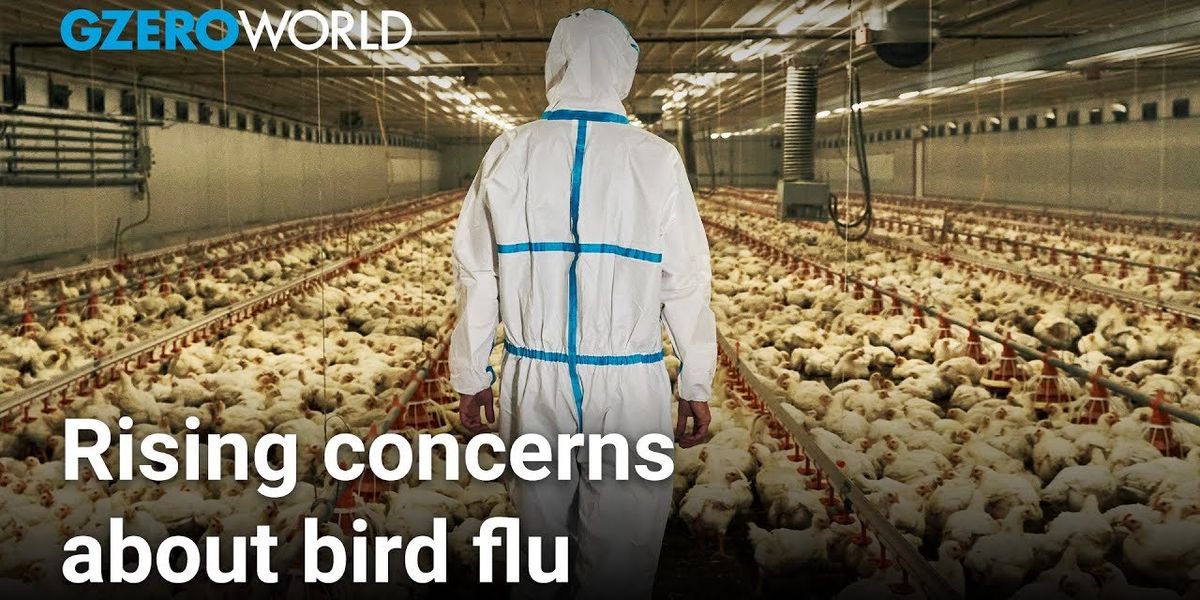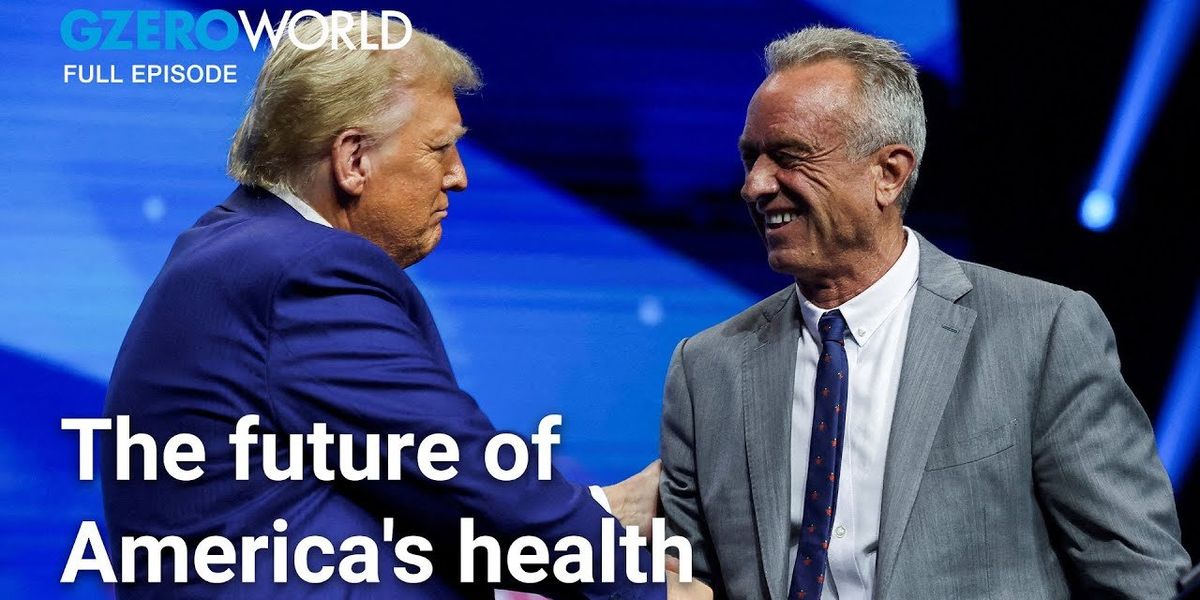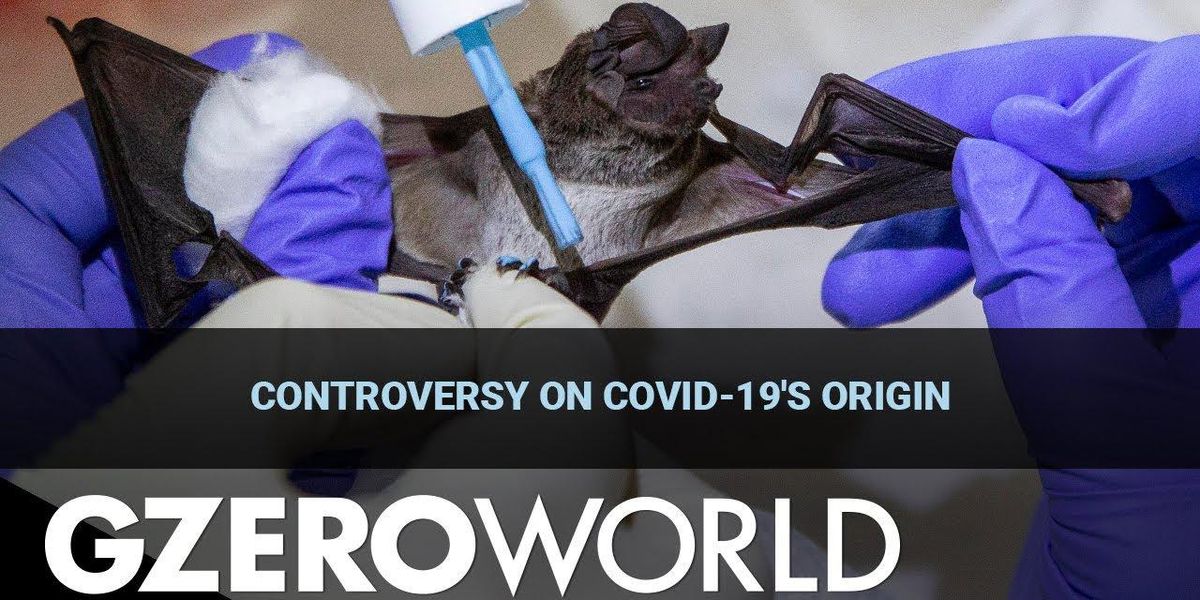Trending Now
We have updated our Privacy Policy and Terms of Use for Eurasia Group and its affiliates, including GZERO Media, to clarify the types of data we collect, how we collect it, how we use data and with whom we share data. By using our website you consent to our Terms and Conditions and Privacy Policy, including the transfer of your personal data to the United States from your country of residence, and our use of cookies described in our Cookie Policy.
{{ subpage.title }}
Should we worry about bird flu in the US?
How worried should we be about bird flu spreading to humans in the US? Are rising bird flu numbers the beginning of the next pandemic? On GZERO World with Ian Bremmer, New York Times science and global health reporter, Apoorva Mandavalli says that now is the time to start taking bird flu more seriously. The virus, known as H5N1, has been circulating in the US since 2024 in poultry and dairy cattle, but fears are growing about its spread to humans after the first bird flu death was reported in Louisiana last month. One big reason for that is that the flu virus is very good at adapting, picking up characteristics that keep it spreading. With Robert F. Kennedy Jr. set to lead the US health department, Mandavilli worries about our ability to deal with a bird flu epidemic, especially given his opposition to mRNA vaccines and endorsement of raw milk, which can harbor bird flu virus, posing serious risks to public health.
“Surveillance has been just really, really poor. We don’t actually know what this virus is doing, how it’s evolving, how widely it’s spread,” Mandavilli says, “That first death was quite a wakeup call.”
Watch the full interview on GZERO World: Trump's health agenda—from RFK Jr. to leaving WHO
GZERO World with Ian Bremmer, the award-winning weekly global affairs series, airs nationwide on US public television stations (check local listings).
New digital episodes of GZERO World are released every Monday on YouTube. Don't miss an episode: subscribe to GZERO's YouTube channel and turn on notifications (🔔).
- Trump's health agenda—from RFK Jr. to leaving WHO ›
- Hard Numbers: Trump’s win certified, First bird flu death, Nippon Steel sues Biden, Venezuela jails foreigners, Congo readies mass execution, Dolphins die after oil spill ›
- How Trump is remaking US public health, with NY Times reporter Apoorva Mandavilli ›
- HARD NUMBERS: Bird flu comes for cows, Alberta wildfire season heats up, Canada grants high-flying sanctions exception, Five Eyes take a hard look at 'Dumping' ›
How Trump is remaking US public health, with NY Times reporter Apoorva Mandavilli
Listen: In President Trump’s short time in office, he’s already made sweeping changes to US public health policy—from RFK Jr.’s nomination to lead the health department to withdrawing the US from the World Health Organization. On the GZERO World Podcast, New York Times science and global health reporter Apoorva Mandavilli joins Ian Bremmer for an in-depth look at health policy in the Trump administration, and what it could mean, not just for the US, but for the rest of the world. President Trump has made it clear: he wants to slash government spending and remake institutions like the CDC, NIH, and FDA. But are those plans a much-needed correction to an overly bureaucratic system or prescription for the next pandemic? What do we need to know about bird flu and changes to USAID? Bremmer and Mandavilli discuss RFK Jr.’s influence in Trump’s second term and what the future of health and medical policy in America could look like.
- The Disinformation Election: Will the wildfire of ... - GZERO Media ›
- Ian Bremmer: American democracy at risk thanks to conspiracy theories ›
- What would it mean for the US to leave the World Health Organization? ›
- What can RFK Jr. do for Donald Trump? ›
- Senate hearings: Gabbard and RFK Jr. make it out of committee ›
- Senate grills RFK Jr. on healthcare policy and vaccine statements ›
- Should we worry about bird flu in the US? - GZERO Media ›
Trump's health agenda—from RFK Jr. to leaving WHO
From RFK Jr.’s nomination to lead the health department to an executive order withdrawing the US from the World Health Organization, President Trump has already made sweeping changes to public health policy, and this may be just the beginning. On GZERO World, New York Times Science and Global Health Reporter Apoorva Mandavilli joins Ian Bremmer for an in-depth look at health and medicine in the second Trump administration—and what it could mean, not just for the US, but for the rest of the world. With bird flu numbers rising in the US and a noted vaccine skeptic poised to become the country's most powerful public health official, should we be worried about potential new pandemics or cuts at the CDC and NIH? Will the FDA endorse RFK’s ideas about raw milk and unfluoridated water? RFK gets a lot right about the need to focus on disease prevention and remove toxins fom our food and environment, but many of his ideas are at odds with mainstream medical science, posing a risk to public health. Bremmer and Mandavilli break down the big stories in healthcare right now, and what the future of the US medical establishment could look like.
"We have a huge problem with trust in this country, and that predates RFK Jr.," Mandavilli says, "Now when you have somebody who has made those comments very openly about the CDC not being trustworthy or the FDA not being trustworthy, and that's who's leading the health department, I think we are in real danger of people [not trusting] anything."
GZERO World with Ian Bremmer, the award-winning weekly global affairs series, airs nationwide on US public television stations (check local listings).
New digital episodes of GZERO World are released every Monday on YouTube. Don't miss an episode: subscribe to GZERO's YouTube channel and turn on notifications (🔔).
- Ian Bremmer: American democracy at risk thanks to conspiracy theories ›
- The Disinformation Election: Will the wildfire of ... - GZERO Media ›
- Trump’s rockiest Cabinet picks get spicy hearings ›
- What would it mean for the US to leave the World Health Organization? ›
- What can RFK Jr. do for Donald Trump? ›
- Senate hearings: Gabbard and RFK Jr. make it out of committee ›
- Senate grills RFK Jr. on healthcare policy and vaccine statements ›
- Should we worry about bird flu in the US? - GZERO Media ›
President Donald Trump attends a bilateral meeting with Chinese President Xi Jinping during a G20 leaders summit in Osaka, Japan, in 2019.
Trump creates a power vacuum in the world.
During his first week in office, Donald Trump took steps to withdraw the US from two major international commitments: the Paris Climate Agreement and the World Health Organization.
Trump’s reasoning on both was, broadly speaking, the same: Like many American conservatives, he sees international obligations as needless constraints on US power and sovereignty. But that may create opportunities for other global powers, not least China.
Dragon in the room? With one of the world’s two largest economies (and polluters) out of Paris, the other, China, has an opportunity to shape global norms in its favor. China emits more greenhouse gasses than anyone but is also a world leader in clean energy technology and financing.
Could China look to boost its influence at the WHO as well? Beijing supplies less than 1% of the organization’s annual budget right now, compared to more than 15% (about $1 billion) from the US. China’s relationship with the WHO has been complicated – Beijing, for example, went to great lengths to stymie the organization’s probe into the origin of COVID-19.
The bigger picture: “America First” will entail scaling back from a range of international commitments. But while Trump may abhorobligations, power abhors a vacuum. As the US withdraws, who will fill the gap? In a GZERO world, can anyone?
Donald Trump speaks on the last day of Turning Point's four-day AmericaFest conference on Dec. 22, 2024, in Phoenix.
What would it mean for the US to leave the World Health Organization?
President-elect Donald Trump’s advisors are reportedly urging him to pull the United States out of the World Health Organization on his first day in office, according to a report published Sunday in the Financial Times.
The US currently provides approximately 16% of the WHO’s funding, giving it outsized influence on the institution. Experts say a withdrawal would severely hamper the world’s ability to respond to public health crises like pandemics.
"Politically, Trump’s lack of support could open the door to lowered support from other countries, in an environment of increased skepticism towards international engagement and foreign aid in general—especially among many ascendant right-wing parties in Europe—amid fiscal constraints and pressures to increase defense spending," says Eurasia Group's Laura Yasaitis. "Ongoing pandemic preparedness efforts, such as the pandemic treaty, would be majorly set back, as would other efforts like the polio eradication campaign."
It’s not an empty threat. Trump actually initiated the process of leaving the WHO in 2020, at the height of the COVID-19 pandemic, accusing the organization of being controlled by China. He never followed through on the actual withdrawal, however, and Joe Biden re-established ties in 2021.
This time around, Trump has aligned himself with figures whose views on healthcare are well outside the scientific consensus. Robert F. Kennedy, Jr., a vociferous opponent of vaccination, is tapped to lead Health and Human Services, while David Weldon, another anti-vaxxer from the fringe, is set to lead the Centers for Disease Control. Incoming Food and Drug Administration commissioner Martin Makary has also questioned the benefits of certain vaccines, like hepatitis B and COVID boosters. With advisers like these, the WHO would be smart to start planning for a pullout, even if it doesn’t happen on Jan. 20.
Beijing won’t butt in on this one, of course, since they stand to gain the most from US healthcare isolationism. If Trump was worried about Chinese control of the WHO back in 2020, pulling out in 2025 would all but guarantee that Beijing steps into the void.
A nurse administers a malaria vaccine to an infant at the health center in Datcheka, Cameroon January 22, 2024.
Hard Numbers: Cameroon rolls out kids malaria vaccine, Gaza death toll hits grim milestone, Deadly winter weather grips US, Massive earthquake hits China, Benito the giraffe migrates south
250,000: Cameroon began rolling out the world’s first malaria vaccine program for children on Monday. The country aims to vaccinate roughly 250,000 kids throughout 2024 and 2025. The WHO-approved vaccine, Mosquirix, is 30% effective and requires four doses. But it’s being portrayed as an important new safeguard against the mosquito-borne illness, which infects roughly 250 million people in Africa each year.
25,295: At least 25,295 Palestinians have been killed in Gaza since fighting between Hamas and Israel broke out on Oct. 7, and roughly 63,000 have been injured, the territory’s health ministry said Monday. Meanwhile, the Israeli military said three of its soldiers were killed in southern Gaza on Monday, bringing the IDF’s death toll in the war so far to 198.
95: There have been at least 95 weather-related deaths across the United States in the past week as winter storms slammed several states. At least 25 weather-related deaths were recorded in Tennessee alone, as well as 16 in Oregon.
7.1: A 7.1-magnitude earthquake hit a mountainous, remote part of China’s Xinjiang region early on Tuesday morning, according to the state-run Xinhua News Agency, and the tremors were felt as far away as Delhi, India. Limited damage has been reported thus far.
1,200: A giraffe named Benito embarked on a 50-hour journey on Monday in search of better weather – and perhaps even love (a new mate). Benito will journey 1,200 miles south from the colder border climes of Ciudad Juarez, Mexico, to Africam Safari park in the state of Puebla, where he will find three female giraffes waiting for him. !Buena suerte, Benito!
A mother holds her daughter's arm as a healthcare worker administers the child with Pfizer-BNT covid-19 vaccine in Taiwan.
COVID vaccine rollout: Taking stock 3 years on
It’s been almost three years since the World Health Organization declared COVID-19 a global pandemic.
Since then, we have gone from the fear of greeting one another in public to the horrors of overcrowded ERs and morgues — to the remarkably fast development of a vaccine and its uneven rollout. Nearly 7 million people have died worldwide, and while the virus is still out there, most countries now have access to effective jabs.
How did we do? In mid-2020, many of us were visiting loved ones through hospital windows, spraying our grocery bags with bleach, and wondering whether public life would ever again go “back to normal.” It seemed like the horror would never end, but a break in the clouds came in Dec. 2020, with the first mRNA vaccines making their way into arms in the US and UK. (Chinese jabs were developed first but proved less effective, and no one remembers Russia’s miracle drug that never was.)
While it seemed like a long wait, the vaccines were rolled out in record time. “We had a virus that was not known to science before December 31, 2019, and we had a vaccine in people's arms in December 2020,” says Dr. Amesh Adajla. a senior scholar at the Johns Hopkins Center for Health Security.
Prior to COVID, the fastest-ever rollout of a vaccine was for mumps, and that took nearly four years. Within 12 months, the coronavirus jab was available thanks to concentrated research. Decades of DNA research enabled scientists to being designing the mRNA for the COVID vaccine as soon as genetic code became available.
“Various scientific groups and manufacturers were able to provide enough doses to do very big studies very quickly, so we had answers super early,” says Dr. Margaret Ann Harris, an epidemiologist at the WHO. “Never in the history of humanity have we had really good data so quickly.”
Today, some 5.5 billion people around the globe – 72% of the population – have received at least one dose. But in the early months, the rollout was slow and uneven.
Global inequities in access and high rates of vaccine hesitancy made the world vulnerable to new variants. Vaccine nationalism — the me-first approach to battling COVID — saw Western countries opting to inoculate their own populations before sending vaccines abroad. But, as Ian Bremmer told us then, the race to outsmart COVID was (and is) global.
Health officials in early 2021 stressed the need to treat vulnerable populations around the globe first — and not only for humanitarian reasons. After all, outbreaks anywhere put everyone in danger of new mutations that could compromise the existing vaccines, as we’ve seen to varying degrees with both the delta and omicron variants.
The COVAX initiative worked to get vaccines to the rest of the world — to date delivering nearly 2 billion doses to 146 countries — but supply issues and vaccine nationalism slowed their efforts early on. Dr. Harris says she became “the most hated person in Britain” in early 2021 for saying that the next step after vaccinating the at-risk population at home should be to send jabs to vulnerable groups abroad.
So how can we do better next time? It’s perhaps no surprise that domestic politics pushed governments to cater to their own populations first.
“Politicians will always default to protectionism. The same thing happened during the 2009 H1N1 influenza pandemic when Australia developed the first vaccine and they put export restrictions on it,” says Adajla.
The only way to avoid that is to make plans now. “We must put a clear strategy in place to distribute vaccines globally, put aside what keeps individual groups happy and go for what really needs to be done for humanity,” says Harris, noting how there are still plenty of countries where under 40% are vaccinated against COVID today
A WHO treaty is in the works that lays out recommendations for pandemic-related international cooperation, preparedness, and response. We’ll be watching to see whether it can help protect us from the scourge of vaccine nationalism.What is the real origin of the COVID-19 virus?
A controversial new World Health Organization report on the origins of the coronavirus that suggests it likely originated from a bat but transferred to humans via an intermediary animal. Could the virus have emerged from a Chinese lab, as former CDC Director Robert Redfield recently suggested? That's the least likely scenario, says the WHO's chief scientist, Dr. Soumya Swaminathan. "The betacoronaviruses are very, very common in bats and there's a lot of genetic similarity between the SARS-CoV2 and many of the viruses in the...bat species," Dr. Swaminathan told Ian Bremmer in an interview on GZERO World, airing on US public television stations starting April 9. Check local listings.
Watch the episode: Vaccine nationalism could prolong the pandemic


